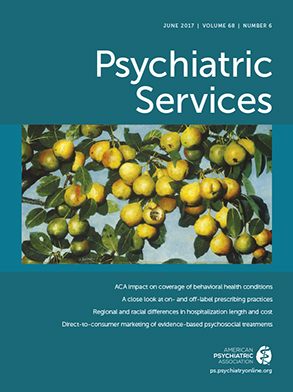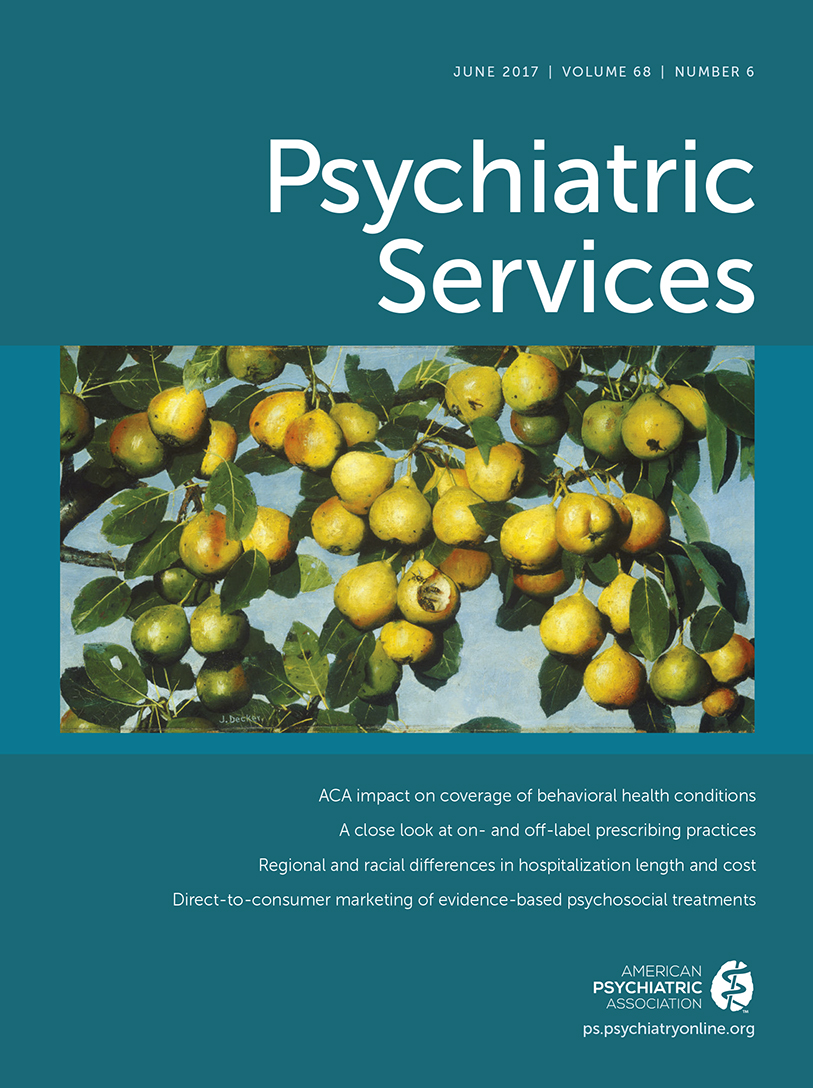Assertive community treatment (ACT) is an evidence-based practice that strives to support community-based recovery for individuals with serious mental illness (
1,
2). Early studies suggested that withdrawal of ACT services led to loss of participant gains (
3). However, an emerging literature demonstrates that individuals can transition from ACT successfully, sustaining their recovery when readiness for transition is assessed, the appropriate services are in place, and the transition is properly coordinated (
4–
6).
In New York State, the Office of Mental Health (NYSOMH) implemented ACT in the early 1990s. In 2008, a total of 79 ACT teams were operating and could serve about 5,000 individuals. By 2014, the ACT system had grown to 82 teams to raise capacity to approximately 5,200. As the NYSOMH ACT program reached full capacity, a growing waiting list developed (
7,
8). Consequently, NYSOMH policy guidance began to focus on transitioning participants through ACT so that more people in need could receive this service. Thus, strategies were developed to shift the ACT model from its original, time-unlimited orientation to approaches that routinely promote participant transition to less intensive services. A focus on shortening time on an ACT team while maintaining quality has become increasingly critical as New York State shifts to a managed care environment.
Strategies included the development of an ACT Transition Readiness Scale (TRS) to monitor participants’ readiness for transition from ACT (
9), a learning collaborative focused on transition practices (
8), and a biannual report for monitoring the flow of participants through ACT.
The TRS (
9) was developed to assist ACT teams in assessing participants’ suitability for transition to less intensive services in the community. It uses administrative data from seven substantive domains—housing stability, psychiatric hospitalization, use of emergency services, service engagement, medication compliance, criminal justice involvement, and incidence of harmful behaviors—to produce a report of the number of participants on each team who are likely to be ready for transition from ACT. The learning collaborative demonstration project supported statewide transition efforts while promoting recovery, which led to a series of recommendations for transition practices (
8).
The ACT Performance Packet, a set of reports disseminated to ACT teams biannually, includes metrics related to participant flow and post-ACT outcome. To determine how ACT’s performance was monitored during this period of promoting transition, we examined the ACT Performance Packet at two time points: 2008, representing the initial dissemination of the packet to ACT teams, and December 2014.
Metrics Examined
The NYSOMH used three administrative data sets to create the ACT Performance Packet. ACT providers enter individual-level information into NYSOMH’s Web-based Child and Adult Integrated Reporting System (CAIRS) at admission, annual follow-ups, and disengagement from services. These data were used to construct metrics of time in ACT, rate of census turnover, and reason for leaving ACT services. In addition, Medicaid claims and NYSOMH’S Mental Health Automated Recordkeeping System (MHARS) were used to monitor post-ACT patterns of inpatient and outpatient behavioral health service utilization in both the NYS-operated and private and local systems of care. These data were used to determine rates of post-ACT ambulatory follow-up and psychiatric hospitalization.
Five key performance metrics were examined at state, regional, and ACT team levels. Two metrics, median time in ACT and annual ACT participant turnover rate, describe the dynamics of participant flow through ACT. Three metrics, percentage of individuals leaving ACT who met treatment objectives, post-ACT ambulatory follow-up, and post-ACT psychiatric hospitalization, are measures of outcome and bring attention to service quality as efforts to promote flow were undertaken. These metrics are described in greater detail below.
Median time in ACT was assessed with Kaplan-Meier survival analysis. The cohort used was all ACT episodes from 2003, up to the last day of the assessed period. For 2008 and 2014, the metric included all individuals enrolled in ACT through the end of 2008 (N=8,526) and 2014 (N=17,106), respectively. Median time in ACT, by this approach, is the month when the estimated cumulative probability of leaving ACT is 50%.
Annual ACT participant turnover rate is a measure of participant flow through the ACT program. It was calculated with a 12-month cohort of individuals who left ACT service (1,124 individuals in 2008 and 1,369 in 2014) within the past 12 months divided by the census on the last day of that year.
The measure for percentage of individuals leaving ACT who met treatment objectives also used a 12-month discharge cohort of participants who transitioned from ACT. A CAIRS item captures the provider’s description of the reason an individual stopped receiving ACT. The metric is the percentage of individuals leaving ACT in the past 12 months for whom “client substantially met program objectives” is reported (N=1,124 in 2008 and N=1,369 in 2014).
Post-ACT ambulatory follow-up uses data extracted from Medicaid claims for a 12-month, Medicaid-eligible, discharge cohort and assesses whether individuals leaving ACT receive outpatient behavioral health services within 90 days of transitioning from ACT (N=318 in 2008 and N=573 in 2014).
The post-ACT psychiatric hospitalization measure uses data extracted from Medicaid claims and MHARS for a 12-month discharge cohort. This metric assesses rates of psychiatric hospitalization in a New York State Department of Health, NYSOMH licensed hospital, or NYSOMH-operated state psychiatric center within 90 days of leaving ACT (N=89 in 2008 and N=122 in 2014).
Outcomes Between 2008 and 2014
Between 2008 and 2014, individuals receiving ACT showed a decrease of one year in median time in ACT, from 44.4 months to 32.4 months. Turnover rate for ACT participants increased from 25% in 2008 to 28% in 2014. Regarding outcomes, the percentage of participants who met ACT treatment objectives and transitioned from ACT rose from 13% in 2008 to 25% in 2014. In addition, the percentage of Medicaid-eligible individuals with an ambulatory follow-up within 90 days of leaving ACT increased from 50% in 2008 to 61% in 2014, whereas the percentage with a psychiatric hospitalization within 90 days of disengagement from ACT decreased from 14% to 13%. [An online supplement provides details.]
Discussion and Conclusions
A statewide data-driven administrative strategy introduced in 2008 supplemented NYSOMH policy guidance to promote participant transition from ACT. Transition-focused performance indicators focused on the system-level dynamics of transition while also monitoring ACT service quality using selected outcome measures. Indicators observed for 2008 and 2014 showed that the ACT system in New York State had moved in the desired direction. Median time in ACT declined, and the turnover rate accelerated. Using the same comparison points, outcome indicators show that participant recovery does not appear to have been compromised by the transition of ACT to a time-limited service.
The trend observed in these metrics illustrates that when leaving ACT is appropriate, participants who transition from ACT can continue to be successfully supported by less intensive services in the community. Also, New York State’s shift to a managed health care environment has placed more emphasis on shorter time in ACT and on a greater need to demonstrate positive outcomes.
Providers have encountered challenges in facilitating transition for ACT participants. There are often difficulties identifying services that can meet the needs of these individuals, and some community service providers refuse referrals because they fear that individuals leaving ACT are too difficult to treat (
8). One way to possibly address these concerns is through the implementation of health homes, which provide comprehensive care management and coordination, health promotion, and consumer and family support to people affected by chronic conditions (
10).
Statewide monitoring, focused on participant flow through ACT once outcomes are achieved, provides a big-picture view to a state entity concerned with managing the quality of a large and diverse system of ACT teams. However, this approach alone cannot specifically determine the impact of any component of the transition change process. Although high-level performance metrics guide needed improvements, direct support and training of ACT teams are necessary for strengthening areas essential to promoting successful transition practice.
Within the continuum of mental health care, ACT continues to be an important service model for people with serious mental illness. With tools such as the TRS and appropriate ACT performance metrics reports and with the availability of adequate, less intensive community services, ACT providers can not only monitor participant progress but also facilitate transitions for those who have met their service goals. Training for providers in using data to support ACT as a targeted, purposeful, and time-limited service is important for assisting ACT participants on their road to recovery. New York State’s ACT Institute, which provides training and technical assistance to ACT teams, is providing further support in understanding both how to interpret performance data and how to overcome barriers to transition (
11).

